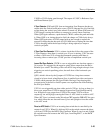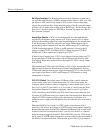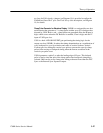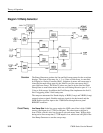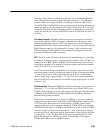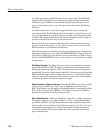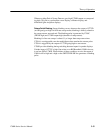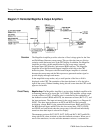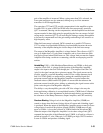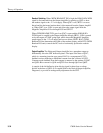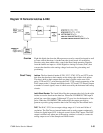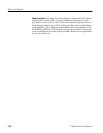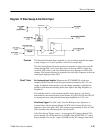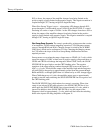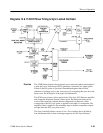
Theory of Operation
1780R-Series Service Manual
3–33
gain of the amplifier is increased. When a gain greater than X5 is selected, the
lower gain transistors are also saturated, turning on up to all six attenuator
transistors for X100 magnification.
The capacitors C572 and C575 provide compensation for the amplifier at gains
less than X50. At gains of X50 and X100 in the line sweep modes, transistor
Q477 is saturated, shorting out the compensation, and the amplifier has the faster
response needed in these high gains for magnifying the line rate sweeps. In field
sweep modes, transistor Q477 is off in all the gain settings, causing the amplifier
to be heavily compensated in all the gain settings and making it less sensitive to
high frequency noise.
When field rate sweep is selected, Q478 is turned on to parallel C478 across
C477 to reduce loop bandwidth. Reducing loop bandwidth increases the noise
immunity of the amplifier during the slower ramps of the field rate sweeps.
The output of the Magnifier Amplifier is voltage limited. The collector of Q573
can go no higher than +12 volts when it saturates, and no lower than one diode
drop below ground when CR469 turns on. This voltage limit prevents the Output
Amplifier from being overdriven or saturating, with the accompanying non-lin-
earities.
Variable Mag. U565, a 1496 Modulator/Demodulator, and CR566, a diode pair,
comprise a Gain Cell. A voltage-divided portion of the Magnifier Amplifier
output is the input to the Gain Cell through pin 1. The output of the Gain Cell
(pin 6) is the signal current plus a quiescent current. The signal current can be
positive, negative, or nulled depending on the DC bias voltage between pins 8
and 10 of U565. Q669 is a current mirror, putting the combined signal and
quiescent current back into the Magnifier Amplifier at a point between the
feedback resistors (R569 and R478). Q668 is a current sink that subtracts the
quiescent current from this point. Adding or subtracting the signal current at this
point varies the gain of the Magnifier Amplifier.
The ability to vary the amplifier gain with a DC bias voltage is the way the
horizontal timing calibration is accomplished from the 1780R-Series Calibration
menu. There are no other adjustments in the horizontal chain to accommodate
the tolerances of the Ramp Generators, Output Amplifier, and CRT sensitivity.
Waveform Blanking. Voltage levels in the Magnifier Amplifier (U580B) are
sensed to detect when the beam is being driven off screen and a blanking signal
is produced. When the output of the Magnifier Amplifier moves toward its lower
voltage limit of one diode drop below ground (CR469), U580B turns off and
turns on U580A. A low at the collector of U580A blanks the Waveform CRT.
When the output of the Magnifier Amplifier is at its other voltage limit (Q573
saturated) the input side of the differential pair, U580D, is off and its collector is
pulled up toward +12 volts. When pin 1 of U580D goes high, VR578 conducts
to turn on U580A and produce a blanking signal.



